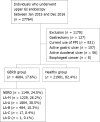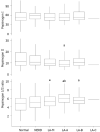Inverse correlation between gastroesophageal reflux disease and atrophic gastritis assessed by endoscopy and serology
- PMID: 35317098
- PMCID: PMC8900577
- DOI: 10.3748/wjg.v28.i8.853
Inverse correlation between gastroesophageal reflux disease and atrophic gastritis assessed by endoscopy and serology
Abstract
Background: Helicobacter pylori (H. pylori) infection is known to prevent the occurrence of gastroesophageal reflux disease (GERD) by inducing gastric mucosal atrophy. However, little is known about the relationship between atrophic gastritis (AG) and GERD.
Aim: To confirm the inverse correlation between AG and the occurrence and severity of GERD.
Methods: Individuals receiving health checkups who underwent upper gastrointestinal endoscopy at Seoul National University Healthcare System Gangnam Center were included. The grade of reflux esophagitis was evaluated according to the Los Angeles classification. Endoscopic AG (EAG) was categorized into six grades. Serologic AG (SAG) was defined as pepsinogen I ≤ 70 ng/mL and pepsinogen I/II ratio ≤ 3.0. The association between the extent of EAG and SAG and the occurrence and severity of GERD was evaluated using multivariate logistic regression analysis.
Results: In total, 4684 individuals with GERD were compared with 21901 healthy controls. In multivariate logistic regression analysis, advanced age, male sex, body mass index > 23 kg/m2, presence of metabolic syndrome, current smoking, and alcohol consumption were associated with an increased risk of GERD. Seropositivity for H. pylori immunoglobulin G antibodies was associated with a decreased risk of GERD. There was an inverse correlation between the extent of EAG and occurrence of GERD: Odds ratio (OR), 1.01 [95% confidence interval (CI): 0.90-1.14] in C1, 0.87 (0.78-0.97) in C2, 0.71 (0.62-0.80) in C3, 0.52 (0.44-0.61) in O1, 0.37 (0.29-0.48) in O2, and 0.28 (0.18-0.43) in O3. Additionally, the extent of EAG showed an inverse correlation with the severity of GERD. The presence of SAG was correlated with a reduced risk of GERD (OR = 0.49, 95%CI: 0.28-0.87, P = 0.014).
Conclusion: The extent of EAG and SAG exhibited strong inverse relationships with the occurrence and severity of GERD. AG followed by H. pylori infection may be independently protect against GERD.
Keywords: Atrophic gastritis; Gastroesophageal reflux disease; Helicobacter pylori; Pepsinogen; Reflux esophagitis.
©The Author(s) 2022. Published by Baishideng Publishing Group Inc. All rights reserved.
Conflict of interest statement
Conflict-of-interest statement: The authors declare that they have no conflicts of interest to disclose.
Figures







Similar articles
-
Helicobacter pylori infection and gastritis: the Systematic Investigation of gastrointestinaL diseases in China (SILC).J Gastroenterol Hepatol. 2011 May;26(5):908-15. doi: 10.1111/j.1440-1746.2010.06608.x. J Gastroenterol Hepatol. 2011. PMID: 21198827
-
Differences in clinical characteristics between patients with endoscopy-negative reflux disease and erosive esophagitis in Japan.Am J Gastroenterol. 2005 Apr;100(4):754-8. doi: 10.1111/j.1572-0241.2005.40966.x. Am J Gastroenterol. 2005. PMID: 15784015
-
Relationship between endoscopic gastric abnormalities and colorectal polyps: a cross-sectional study based on 33439 Chinese patients.Int J Med Sci. 2023 Jan 22;20(2):219-224. doi: 10.7150/ijms.80543. eCollection 2023. Int J Med Sci. 2023. PMID: 36794160 Free PMC article.
-
Helicobacter pylori infection, reflux esophagitis, and atrophic gastritis: an unexplored triangle.Am J Gastroenterol. 1998 Mar;93(3):394-400. doi: 10.1111/j.1572-0241.1998.00394.x. Am J Gastroenterol. 1998. PMID: 9517647 Review.
-
Interactions between Helicobacter pylori and gastroesophageal reflux disease.Esophagus. 2019 Jan;16(1):52-62. doi: 10.1007/s10388-018-0637-5. Epub 2018 Aug 27. Esophagus. 2019. PMID: 30151653 Review.
Cited by
-
Medication use and risk of reflux oesophagitis.BMJ Open Gastroenterol. 2024 Dec 16;11(1):e001468. doi: 10.1136/bmjgast-2024-001468. BMJ Open Gastroenterol. 2024. PMID: 39689936 Free PMC article.
-
Role of Laryngopharyngeal Reflux Changes in Children with Adenoid Hypertrophy: A Randomized Controlled Prospective Study.Evid Based Complement Alternat Med. 2023 Feb 6;2023:5628551. doi: 10.1155/2023/5628551. eCollection 2023. Evid Based Complement Alternat Med. 2023. PMID: 36793763 Free PMC article.
-
Elevated serum pepsinogen level predicts postoperative nausea and vomiting and pain in females with obesity following laparoscopic sleeve gastrectomy.Int J Obes (Lond). 2025 Apr;49(4):665-672. doi: 10.1038/s41366-024-01688-z. Epub 2024 Nov 28. Int J Obes (Lond). 2025. PMID: 39609600
-
Risk factors and 26-years worldwide prevalence of endoscopic erosive esophagitis from 1997 to 2022: a meta-analysis.Sci Rep. 2023 Sep 14;13(1):15249. doi: 10.1038/s41598-023-42636-7. Sci Rep. 2023. PMID: 37709957 Free PMC article.
-
Predicting reflux symptom recurrence: The impact of gastroesophageal junction indicators and body mass index among outpatients.Exp Ther Med. 2023 May 31;26(1):351. doi: 10.3892/etm.2023.12050. eCollection 2023 Jul. Exp Ther Med. 2023. PMID: 37324506 Free PMC article.
References
-
- Vakil N, van Zanten SV, Kahrilas P, Dent J, Jones R Global Consensus Group. The Montreal definition and classification of gastroesophageal reflux disease: a global evidence-based consensus. Am J Gastroenterol. 2006;101:1900–20; quiz 1943. - PubMed
-
- Kim N, Lee SW, Cho SI, Park CG, Yang CH, Kim HS, Rew JS, Moon JS, Kim S, Park SH, Jung HC, Chung IS H. pylori and Gerd Study Group of Korean College of Helicobacter and Upper Gastrointestinal Research. The prevalence of and risk factors for erosive oesophagitis and non-erosive reflux disease: a nationwide multicentre prospective study in Korea. Aliment Pharmacol Ther. 2008;27:173–185. - PubMed
-
- Youn YH, Kang YW, Ahn SH, Park SK. Prevalence alteration of reflux esophagitis in recent years. Korean J Gastrointest Endosc. 2001;23 (3):144–148.
MeSH terms
LinkOut - more resources
Full Text Sources
Medical
Miscellaneous

